Can’t Do a Deadlift? These 5 Exercises Can Help You Finally Nail the Move
Can't do a deadlift? Discover the best exercises to help you nail this exercise, according to fitness experts.
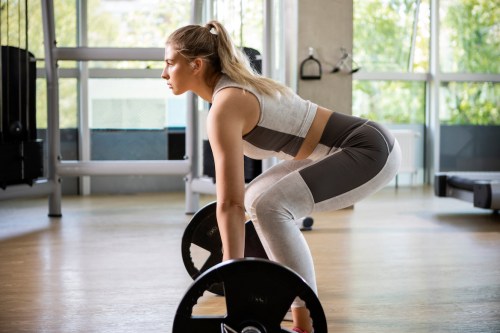
There’s a reason the deadlift is considered the “king of all exercises.”
Experts in This Article
personal trainer and owner of Redefining Strength
sports physical therapist at TRIA Physical Therapy
“A deadlift is one of the most functional exercises you can perform at the gym and is extremely efficient in using a large number of muscle groups,” says Lauren Loberg, PT, DPT, sports physical therapist at TRIA Physical Therapy in Bloomington, Minnesota.
However, the deadlift is also pretty complex. Many people struggle to get it right or come away with nagging back pain, leading them to avoid deadlifts altogether. In doing so, they miss out on the many benefits deadlifts have to offer.
Here, experts share what makes deadlifts so difficult and what exercises can help you (finally) deadlift successfully.
Why deadlifting can be so challenging
Watch someone deadlift; you may be fooled into thinking they’re simply picking up weight off the floor. But the deadlift is a bit more involved than that.
“Deadlifts require multiple large muscle groups to work together in proper sequence, which is part of what makes it so challenging,” says Cori Lefkowith, CPT, personal trainer and owner of Redefining Strength, a comprehensive online coaching program.
“It’s easy to overload muscles not meant to carry the load in the deadlift because it is a complicated exercise,” Lefkowith adds.
The deadlift is a full-body exercise, but it primarily recruits your abdominals, latissiumus dorsi (the “lats,” which are large fan-shaped muscles that take up much of your back), trapezius (broad muscles that span from the base of your neck to the middle of your back, also known as the “traps”), glutes (the meaty buttocks muscles), and hamstrings (the muscles in the back of your thighs).
In particular, many people struggle to coordinate their muscles for the main movement of the deadlift: the hip hinge that happens when you bend over to pick up the weight.
“Because as much as it may seem like just leaning over, hinging at the hips is more about sitting the butt back,” Lefkowith says.
Simply leaning over to pick up the weight shifts more of the load onto the back, leading to lower back stiffness and pain.
The hip hinge tends to be an unfamiliar movement for many people, as it requires engaging muscles (the glutes and hamstrings) we’re not used to activating, thanks to long periods spent seated during the day, Lefkowith notes.
In addition, many people have tight hips, hamstrings, and ankles, which limits how far they’re able to hinge without rounding their back, Dr. Loberg says.
“A deadlift is one of the most functional exercises you can perform at the gym and is extremely efficient in using a large number of muscle groups.” —Lauren Loberg, PT, DPT
The 5 best exercises to help you nail deadlifts
The following strength exercises are Lefkowith’s top choices for people who are interested in perfecting the deadlift. Each movement builds a foundational skill or the strength needed to deadlift properly.
Add these into a lower-body or back-focused workout or perform as a standalone routine once per week.
1. Wall hip hinge
To do a deadlift, you must nail the hip hinge. The wall hip hinge is an excellent way for beginners to learn to perform this essential movement before adding weight. Having a wall behind you gives you something to hit with your glutes and can be a great way to practice the hip hinge properly.

- 1.Stand about 3 to 6 inches from wall, facing away.
- 2.Step your feet hip-width apart and point your toes forward.
- 3.Keeping your back flat, hinge forward at your hips and push your butt back to touch the wall behind you. Keep your knees soft.
- 4.Drive through your feet to return to standing tall. Squeeze your glutes at the top to straighten your hips.
- 5.Do 3 to 4 sets of 15 to 20 reps.
Tip: If the wall hip hinge feels too easy, progress to a resistance band hip hinge. Anchor a resistance band to a sturdy object at hip height and place it across your hips. Facing away from the anchor point, step forward until there’s tension on the band. Then, perform a hip hinge.
2. Hip thruster
“This move is honestly one of the best accessory exercises to strengthen your deadlift,” Lefkowith says.
The hip thruster involves moving your hips through a large range of motion, which really hones in on the muscles most responsible for the deadlift movement: your glutes, hamstrings, and even quads, she explains.
“It is [also] great to help with that glute drive in the deadlift.”
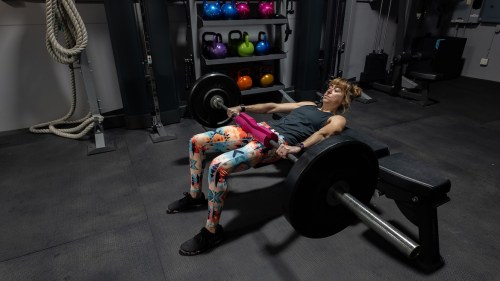
- 1.Sit on the floor facing away from a sturdy bench.
- 2.Set your upper back on the bench. Bend your knees to plant your feet hip-width apart on the ground close to your butt.
- 3.Push through your heels and upper back to lift your glutes off the floor, squeezing your glutes to press your hips as high as possible. Avoid arching your lower back at the top of the movement by keeping your belly button pulled in toward your spine.
- 4.Pause at the top before slowly reversing the movement to lower your glutes back down.
- 5.Do 3 to 4 sets of 6 to 12 reps.
Tip: To make the exercise harder, hold a barbell or dumbbell over your hips. If this exercise is too challenging even with bodyweight only, perform the exercise with your head, shoulders, and back on the floor.
3. Cable hinged lat pushdown
This variation of the lat pulldown strengthens the lats in a hinged position, which translates well to the deadlift.
“The hinged lat pushdown teaches us to engage our lats to secure the [weight] close to our body and keep everything engaged,” Lefkowith says.
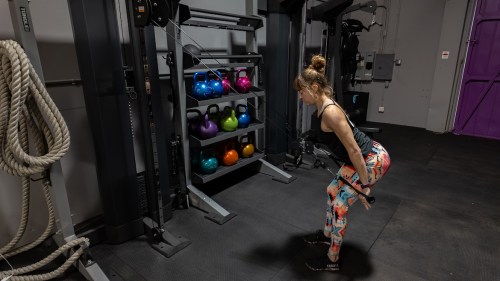
- 1.Adjust the handle attachment of a cable machine so the handle is anchored above head height. If possible, use two separate handles anchored side-by-side. If this isn’t possible, work one arm at a time.
- 2.Stand facing the cable machine. Grip a handle in each hand (or one handle with one hand) and step away from the anchor point until your arms are fully extended, shoulders next to your ears, palms facing the floor.
- 3.Keeping your arms extended, hinge forward at your hips and push your glutes back.
- 4.From this position, squeeze your shoulder blades to pull the handles down alongside your thighs, keeping your arms straight.
- 5.Slowly reverse the movement to return your arms overhead.
- 6.Do 3 to 4 sets of 10 to 15 reps.
4. Cable step-up
While step-ups typically involve more knee-bend (flexion) than you need for a deadlift, this variation helps you build other skills you can transfer to the deadlift. In particular, it teaches you to drive through your feet to lift the weight off the floor.
“We want to think of the deadlift as pushing the ground away so the bar [or weight] moves up. By anchoring the cable down low with the step-up, you have to push the bench away with your foot to drive up, which can really help you train that focus for your deadlift,” Lefkowith says.
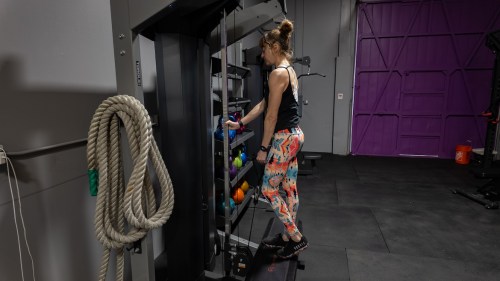
- 1.Place a bench or exercise step in front of a cable machine. (The taller the bench or step, the harder the exercise.) Adjust the handle attachment so the handle is anchored at the lowest point of the cable machine.
- 2.Stand facing the bench or step and grip the cable handle in your left hand, palm facing in. Keep your arm straight.
- 3.Place your right foot flat on the bench or step so your right knee is bent. Your left foot remains on the ground, your left leg straight.
- 4.Lean forward to shift your weight onto your right leg and lightly grip the cable support bar with your right hand.
- 5.Push your right foot into the bench or step to straighten your right leg, keeping your left arm extended. Tap the bench or step with your left foot or let it hover behind you.
- 6.Reverse the movement slowly to bend your right knee and return your left foot to the floor.
- 7.Do 3 to 4 sets of 6 to 12 reps per leg.
5. Bent-over row
Bent-over rows are a great all-around back-strengthening exercise. A strong back enables your upper body to support heavier loads while you build up to a deadlift, Lefkowith notes.
As a bonus, the bent-over row helps you to build a strong back in a hinged position. “Holding that position allows you to focus on loading your glutes,” Lefkowith says. Pushing weight back into your legs takes some of the load off your lower back, helping prevent pain.
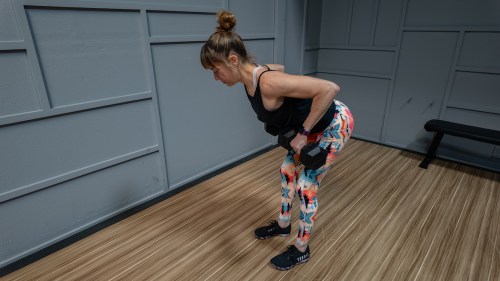
- 1.Stand tall with your feet hip-width apart and hold a dumbbell in each hand down by your sides.
- 2.Keeping your back flat, hinge forward at your hips so your arms extend straight down toward the floor, palms facing you.
- 3.If you feel tension in your low back, bend your knees a bit and sit back into your hips.
- 4.Tighten your core and pull the dumbbells up to your ribcage so your elbows point toward the ceiling.
- 5.Squeeze your shoulder blades at the top of the movement before lowering the dumbbells back down with control until your arms are fully extended and you feel a slight stretch in the shoulders.
- 6.Do 3 to 4 sets of 6 to 12 reps.
Sign Up for Our Daily Newsletter
Get all the latest in wellness, trends, food, fitness, beauty, and more delivered right to your inbox.
Got it, you've been added to our email list.










